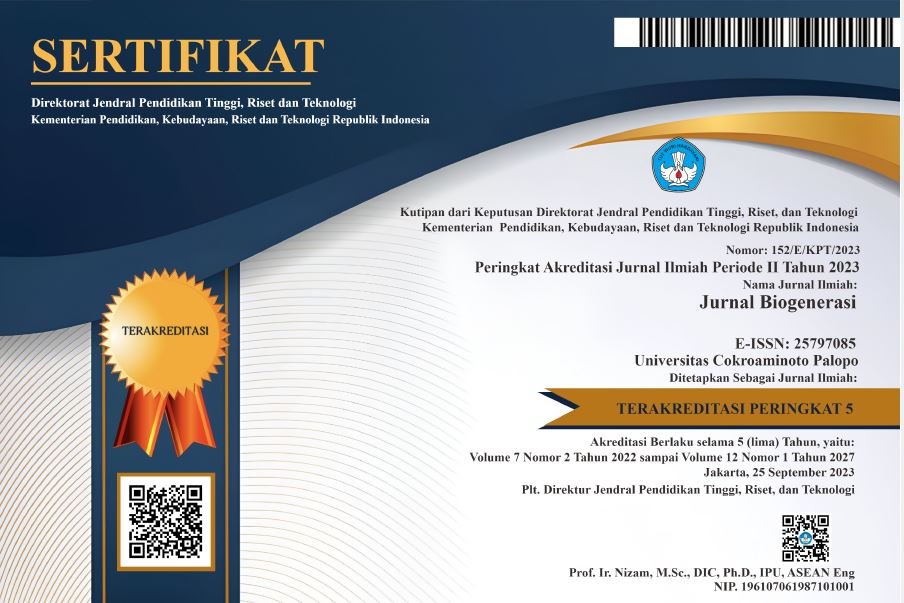KARATERISTIK MORFOLOGI DAUN TANAMAN TOMAT (SOLANUM LYCOPERSICUM L.) PADA KONDISI LINGKUNGAN YANG BERBEDA
DOI:
https://doi.org/10.30605/biogenerasi.v10i2.6047Keywords:
Response, morphology, tomato leaves, different environmentsAbstract
Tomato (Solanum Lycopersicum L.) is a horticultural plant from the Solanaceae family that has potential as a vegetable. Tomatoes can grow in various land conditions, both in highlands and lowlands. However, the production of this plant has not been optimal in meeting the needs of the community recently due to various environmental factors. To adapt to different environmental stress conditions, it is important to understand how the plant responds, particularly the morphological responses of tomato leaves in various environmental conditions.This research was conducted from September 2024 to January 2025 in Kamang Magek and the city of Padang. The research method is experimental, comparing the morphological characteristics of tomato leaves, including leaf length and width, petiole length, and the number of leaf veins. The data were analyzed using a t-test at a 5% significance level.The results show that the morphological characteristics of tomato leaves exhibit significant differences in terms of leaf length and width between Kamang Magek and the city of Padang. The average leaf length in Kamang Magek is about 55.5 cm, while in the city of Padang, it is 25.60 cm. The average leaf width in Kamang Magek is approximately 23.30 cm, whereas in the city of Padang, it is 22.95 cm. However, when considering petiole length and the number of leaf veins, no significant differences were observed between the city of Padang and Kamang Magek.
Downloads
References
Bibi, A., H. A. Sadaqat, H. M. Akram & M. I. Mohammed. (2010). Physiological markers for screening Sorghum (Sorghum bicolorL.). Germplasm under water stress condition.Int. J. Agric. Biol. 12(3): 451-455
Broughton, WJ, Hernandez, G, Blair M, Beebe S, Gepts P & VJ 2003, ‘Beans (Phaseolus spp.) - model food legumes’, Plant Soil, vol. 252, pp. 55–128
Fauzi, M. D., Sukaris, S., Widiharti, W., Rahim, A. R., & Farikhah, F. (2023, October). Edukasi Amdal Limbah Pertanian Padi dan Jagung Beserta Pengolahan Berbasis Zero Waste. In Prosiding Seminar Hasil Pengabdian Kepada Masyarakat dan Kuliah Kerja Nyata (Vol. 1, No. 1, pp. 474-476).
Hamzah MF, 2010. Studi Morfologi dan Anatomi Daun Edelweis Jawa (Anaphalis javanica) pada Zona Ketinggianyang Berbeda di Taman. Skripsi. UIN Malang
Jones,K., & Brown, T. (2019). Environmental Pollution and Human Health: Understanding the Risks. Environmental Research Letters, 14(3), 034017.
Kasiman, K; Ramadhani,D.S; & Syafrudin, M. 2017. Karakteristik Morfologi dan antomis daun tumbuhan tingkat semai pada paparan cahaya yang berbeda di Hutan Pendidikan Fakultas Kehutanan Universitas Mulawarman. Ulin -JHut Trop Vol 1 No 1 . 29 – 38.
Lawi, A., Intizhami, N. S., Mukhtarom, R., & Amir, S. (2022). Klasifikasi Penyakit Citra Daun Tanaman Tomat Dengan Ensemble Convolutional Neural Network. In Seminar Nasional Teknik Elektro dan Informatika (SNTEI) (Vol. 8, No. 1, pp. 239-243).
Lee, BR, & Ibáñez, I. (2021). Peningkatan kemampuan melarikan diri secara fenologis dapat membantu bibit pohon beriklim sedang mempertahankan kinerja demografi dalam kondisi perubahan iklim. Global Change Biology, 27 (16), 3883-3897.
Madhu, M & Hatfield, JL 2015, ‘Elevated carbon dioxide and soil moisture on early growth. response of soybean’, Agricultural Sciences, vol. 6, pp. 263–278.
Nurholis dan Saleh,I. (2019)Hubungan Karakteristik morfofisiologi tanaman Kersen(Muntingiaalabura). AGROVIGOR 12 (2) 47 – 52.
Putri, V.R.W. dan Vauzia. (2021). Karakteristik Morfologi Daun Tumbuhan Yang Dominan di Daerah Aliran Sungai Batang Arau Kota Padang Sumatera Barat. Serambil Biologi. 6(1):40-46.
Smith, P., Calvin, K., Nkem, J., Campbell, D., Cherubini,F.,Grassi,G.& Arneth, A. (2020).Which practices can ensure food security, mitigate and adapt to climate change, and combat land degradation and desertification. Global Change Biology , 26 (3), 1532-1575.
Sulthon, A. M., & Sakya2 danSulanjari, A. T.(2018). AnalisismPertumbuhan Tomat pada Aplikasi ZN Melalui Daun (Doctoral dissertation, Sebelas Maret University). 2(1), 2615-7721
Violle,C; M.L Navas; D. Vile; E. Kazakou; C.Fortunel; I.Hummel and E. Garnier. 2007. Let The Concept of Trait be functional. Oikos 116 (5) 882 - 892
Wahyurini, E., & Suryawati, A. (2021). Budidaya Dan Keragaman Genetik Tomat.LPPM UPN Veteran Yogyakarta.ISBN 978-5539-37-9.
Xu, F; W.Guo; W.Xu; Y.Wei and R.Wang.(2009) Leaf morphologycorrelation with water and Light availability: What Consequences for simple and compound leaves Elsevier. Progress in Natural Sciences (19) 1789 - 1798.
Yuliani, Soemarno, Bagyo Y, and Amin SL, 2015. The Relationship between Habitat Altitude, Enviromental Factors and Morphological Characteristics of Pluchea indica, Ageratum conyzoides and Elephantopus scaber. Online Journal of Biological Sciences. Science Publication, 15(3): 143-151.
Downloads
Published
How to Cite
Issue
Section
License
In submitting the manuscript to the journal, the authors certify that:
- They are authorized by their co-authors to enter into these arrangements.
- The work described has not been formally published before, except in the form of an abstract or as part of a published lecture, review, thesis, or overlay journal.
- That it is not under consideration for publication elsewhere,
- That its publication has been approved by all the author(s) and by the responsible authorities – tacitly or explicitly – of the institutes where the work has been carried out.
- They secure the right to reproduce any material that has already been published or copyrighted elsewhere.
- They agree to the following license and copyright agreement.
License and Copyright Agreement
Authors who publish with this journal agree to the following terms:
- Authors retain copyright and grant the journal right of first publication with the work simultaneously licensed under Creative Commons Attribution License (CC BY 4.0) that allows others to share the work with an acknowledgment of the work's authorship and initial publication in this journal.
- Authors are able to enter into separate, additional contractual arrangements for the non-exclusive distribution of the journal's published version of the work (e.g., post it to an institutional repository or publish it in a book), with an acknowledgment of its initial publication in this journal.
- Authors are permitted and encouraged to post their work online (e.g., in institutional repositories or on their website) prior to and during the submission process, as it can lead to productive exchanges, as well as earlier and greater citation of published work.


.png)

